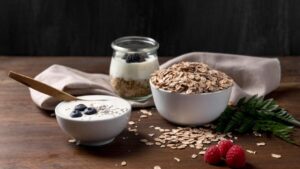In our fast-paced world, many people are on the lookout for quick and nutritious breakfast options. One of the most exciting trends in recent years has been the rise of “ancient grains in a healthy cereal.” But what exactly are ancient grains, and why are they becoming so popular in our cereals? This article will dive into the world of ancient grains, exploring their health benefits, how they fit into a healthy cereal, and how you can easily add them to your diet.
What Are Ancient Grains?
Ancient grains are types of grains that have been grown for thousands of years, long before modern agriculture took over. Some common examples include quinoa, farro, spelt, and barley. Unlike most grains today, which have been refined and stripped of their nutrients, ancient grains are typically whole grains. This means they still have all parts of the grain—the bran, germ, and endosperm—making them more nutritious.
These grains have not only stood the test of time in terms of cultivation but also in their nutritional value. They are packed with essential vitamins, minerals, and fiber. Many ancient grains also contain more protein than conventional grains, making them a great addition to a healthy diet.
The Health Benefits of Ancient Grains
Incorporating ancient grains into your diet can bring a multitude of health benefits. First and foremost, they are excellent sources of fiber. Fiber is important for digestion and can help you feel full longer, which is great for those looking to maintain a healthy weight.
Ancient grains are also rich in antioxidants, which help protect your body from damage caused by free radicals. Free radicals are unstable molecules that can lead to chronic diseases, including cancer. By consuming foods high in antioxidants, you can help support your overall health.
Moreover, many ancient grains are gluten-free or have a lower gluten content than modern grains. This makes them suitable for those with gluten sensitivities or celiac disease. However, always check labels to ensure they meet your dietary needs.
How Ancient Grains Enhance Healthy Cereals
When it comes to breakfast, cereals are a staple in many households. By adding ancient grains to your cereal, you can elevate its nutritional profile significantly. For instance, instead of regular oats, you can choose quinoa flakes or a blend of ancient grains for a unique twist.
Ancient grains can also add a delightful texture and flavor to your cereal. Quinoa has a nutty flavor that pairs well with fruits and nuts, while farro adds a chewy texture that can make your breakfast more satisfying. Mixing different ancient grains can provide a variety of tastes and textures, keeping your morning routine exciting.
Additionally, many companies are now creating cereals specifically designed to include ancient grains. These cereals are often lower in sugar and higher in nutrients than traditional breakfast cereals, making them a better choice for your health.
Easy Ways to Incorporate Ancient Grains into Your Breakfast
There are countless ways to incorporate ancient grains into your breakfast routine. One of the simplest methods is to switch out your regular cereal for one that contains ancient grains. Look for options that highlight grains like quinoa, spelt, or millet on the packaging.
If you prefer to make your breakfast, try adding cooked ancient grains to smoothies or yogurt. Quinoa or farro can be a nutritious and filling addition to a morning smoothie, while millet can add a creamy texture when mixed with yogurt.
You can also make breakfast bowls using ancient grains as a base. Cooked quinoa or barley topped with fruits, nuts, and a drizzle of honey creates a delicious and healthy breakfast. You can even experiment with different toppings to find combinations you love.
Tasty Ancient Grain Recipes for Breakfast
If you’re looking to get creative in the kitchen, here are a few tasty recipes to try:
- Quinoa Breakfast Bowl: Cook quinoa in almond milk and add a dash of cinnamon. Top with sliced bananas, a handful of nuts, and a drizzle of maple syrup for a delicious and nutritious breakfast.
- Farro Fruit Salad: Mix cooked farro with chopped seasonal fruits, a squeeze of lemon juice, and a sprinkle of mint for a refreshing morning salad.
- Millet Porridge: Cook millet with coconut milk, adding vanilla and a touch of sweetener. Top with berries and seeds for added texture and flavor.
- Spelt Pancakes: Substitute spelt flour for regular flour in your pancake recipe for a nutty flavor and added health benefits. Serve with fresh fruit and a drizzle of honey.
- Chia Seed Pudding with Ancient Grains: Combine chia seeds with almond milk and let them sit overnight. In the morning, stir in cooked quinoa and top with your favorite fruits and nuts.
These recipes are not only simple but also packed with nutrients that will give you the energy to start your day right.
Understanding the Nutritional Profile of Ancient Grains
Let’s break down the nutritional benefits of some popular ancient grains to see why they are worth including in your healthy cereal:
- Quinoa: Often called a superfood, quinoa is a complete protein, meaning it contains all nine essential amino acids. It’s also high in fiber, magnesium, and antioxidants.
- Farro: This ancient grain is rich in fiber, protein, and iron. It’s also a good source of magnesium, which is essential for muscle function and energy production.
- Barley: Barley is an excellent source of beta-glucans, a type of soluble fiber that can help lower cholesterol and regulate blood sugar levels. It’s also packed with vitamins and minerals.
- Spelt: Spelt is high in protein and has a nutty flavor. It’s a good source of fiber and essential nutrients like iron and zinc.
- Millet: This tiny grain is rich in magnesium, phosphorus, and antioxidants. It’s gluten-free and easy to digest, making it a great option for those with dietary restrictions.
Understanding the unique nutritional profiles of these ancient grains can help you make informed choices when selecting cereals and other foods.
The Future of Ancient Grains in Our Diets
As we continue to learn more about nutrition and health, the popularity of ancient grains is likely to grow. Many people are turning to these nutritious options not only for their health benefits but also for their unique flavors and textures.
Food manufacturers are catching on to this trend and are developing more products that highlight ancient grains. This means that consumers will have more options when it comes to choosing healthy cereals and other food products.
Furthermore, as people become more interested in sustainable eating practices, ancient grains offer a viable alternative to modern grains that are often heavily processed. Many ancient grains are also grown in more sustainable ways, requiring less water and fewer pesticides than conventional crops.
Conclusion: Embracing Ancient Grains for a Healthier Tomorrow
In conclusion, incorporating ancient grains into your diet is a delicious and nutritious way to enhance your breakfast routine. By choosing “ancient grain in a healthy cereal,” you’re not only making a smart choice for your health but also supporting sustainable agriculture practices.
From quinoa and farro to barley and spelt, these grains bring a wealth of nutrients and flavors to the table. So the next time you’re shopping for breakfast cereals, consider opting for those made with ancient grains. Your body will thank you, and your taste buds will love the variety!






